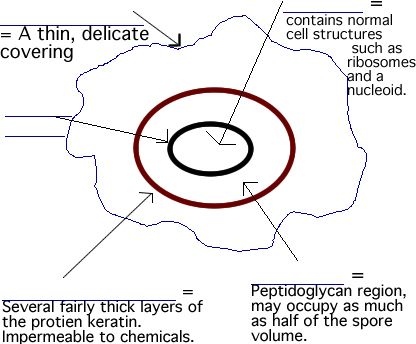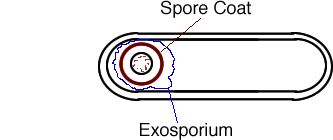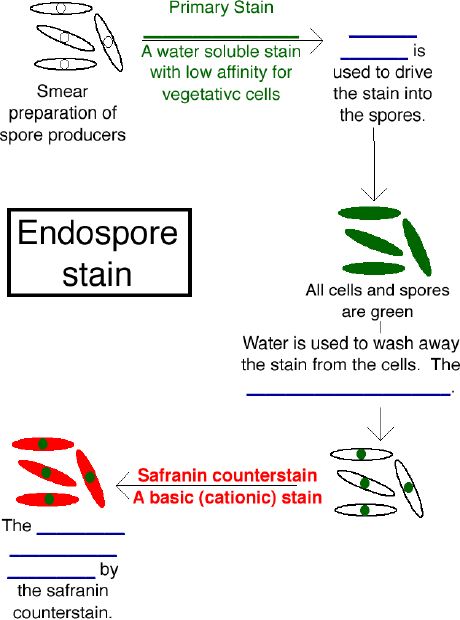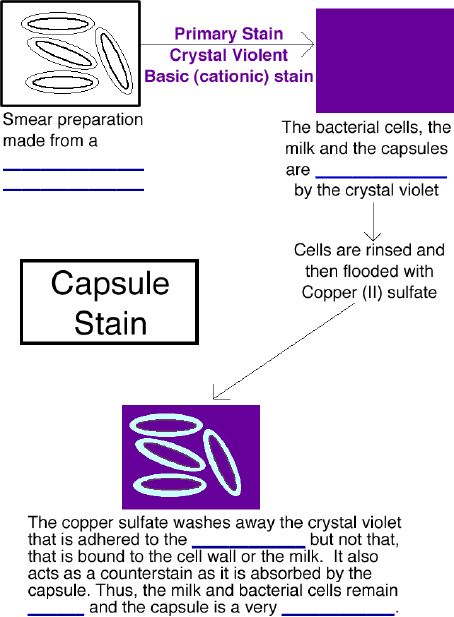Lecture #4: Endospore and Capsule Stains
I. The Bacterial Endospore
A. A _____________________________
that develops within vegetative cells of several genera
1. ___________________________
(rods) (e.g. the pathogen Bacillus anthracis)
2. ___________________________
(rods) (e.g. the pathogens Clostridium botulinum and Clostridium
tetani)
3. ___________________________
(cocci)
B. Develop in nature to allow for survival ___________________________
____________________________.
C. Extraordinarily resistant to _____________________________________
such as heat, UV, chemical disinfectants and desiccation. In fact, some spores
have remained viable for 100,000 yrs.
D. ______________________________ in the
mother cell frequently differs among species and can depend on the time lapsed
after formation.

E. Endospore structure

F. The spore’s mechanism of resistance is ___________________________
_________________________________. Following are some possibilities:
1. ________________________________________
have been found that protect the DNA from heat, radiation and desiccation.
2. The cortex may _________________________________________,
protecting it from heat and radiation.
3. The high concentration of _____________________________ ________________________________ appears to play a role in DNA protection thus enhancing spore resistance to heat, H2O2 and desiccation (Journal of Bacteriology, June 2006, p. 3740-3747, Vol. 188, No.11 (Setlow et. al.)).
II. ___________________________________
(sporogenesis or sporulation)
A. Steps
1. The cell stops growing and the _____________________________.

2. The cell ______________________________________.
A copy of the DNA is enclosed and the ________________________________.

3. The immature spore is ___________________________________.

4. The _________________________ is
laid down in the space between the two membranes.

5. _____________________________________________
are formed.

6. The spore _____________________
and ____________________ _______________________________________.
III. Transformation of dormant spores into active, vegetative
cells.
A. Stages
1. __________________________
- some change in environment (usually exposure to ____________
or certain chemicals) causes the spore to prepare for germination.
2. ________________________
a. Often triggered by the ______________________________
__________________________.
b. The spore takes on water, ___________________________
__________________________________________________.
c. _____________ ____ begins to increase.
3. Outgrowth - the spore core makes new components, emerges
from the remains of the spore coat and ____________________________
___________________________.
IV. ________________________
Endospores
A. Only ____________________________________
produce endospores so these should be the cells used for staining.
B. In addition to resisting heat and chemicals the protein coat of an endospore
is also ________________________________.
Therefore the staining procedure must be fairly ____________________.

http://www.umanitoba.ca/faculties/science/microbiology/wall/210_page/lab%204/spore.htm
V. Bacterial _______________________
A. A well organized _____________________________________________
___________________________.
B. Generally composed of ________________________________________.
C. Help bacteria resist ____________________________
by host phagocytic cells, therefore increasing the ________________________
of these bacteria
(e.g. Streptococcus pneumoniae).
D. Contain a ______________________________________
and can protect ___________________________.
E. Exclude bacterial ________________________
and most hydrophobic ___________________.
F. Can enhance the ability of certain bacteria to ______________________
_______________ (e.g. Streptococcus mutans ________________________
________________________________).
VI. __________________________
bacteria with capsules
A. The polysaccharides and polypeptides in the capsule make
staining difficult, therefore capsule staining procedures generally ________________________
_______________________________ leaving the capsule ______________
________________________________________________. It appears as
a ____________ around the cell.
B. Cells with capsules are not heated as heat treatment _________________
_____________________________ and the shrinkage of the cell can
cause a ________________________.

www.umanitoba.ca/faculties/science/microbiology/wall/210_page/lab%204/capsule.htm
|








